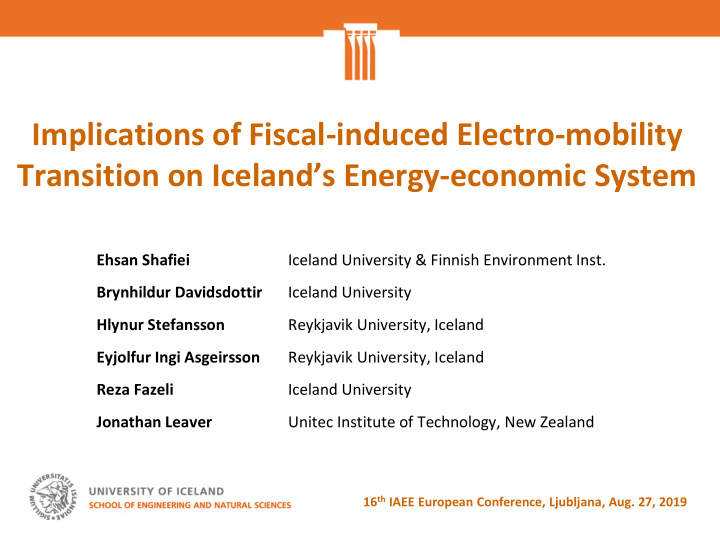



Implications of Fiscal-induced Electro-mobility Transition on Iceland’s Energy -economic System Ehsan Shafiei Iceland University & Finnish Environment Inst. Brynhildur Davidsdottir Iceland University Hlynur Stefansson Reykjavik University, Iceland Eyjolfur Ingi Asgeirsson Reykjavik University, Iceland Reza Fazeli Iceland University Jonathan Leaver Unitec Institute of Technology, New Zealand 16 th IAEE European Conference, Ljubljana, Aug. 27, 2019
Transition to Electro-Mobility: Essentials & Challenges Electro-mobility transition is of great interest to Iceland: o high vehicles-per-capita, rising fleet size, and GHG emissions o isolated energy-system with abundant renewable resources o low-cost electricity from renewable resources Transition challenges/consequences: o major energy-economic challenges for small economies o changes in government revenue and consumer costs Essentials and requisites: o implications of EV transition for energy-economic system o efficiency & effectiveness of policies to support EV transition
Analytical Tools: Integrated Energy-Transport Model A Simulation model based on the System-Dynamics approach Partial equilibrium modelling framework Detailed representation of resources & technologies Incorporating fuel supply infrastructure, fuel prices & consumers Endogenous analysis of energy market dynamics Energy market sectors: Electricity , Hydrogen , Biofuels Yearly time points with bi-weekly steps (~2000 variables)
System-Dynamics Model of Energy-Transport System (UniSyD_IS)
Basic Stock-Flow Model Structure New Vehicle + Adoption + Refueling R Vehilcle Stock Infrastructure + + Fuel Demand + Fuel Demand Fuel Price + ? - New Vehicle Vehilcle Stock Adoption +
Model Implementation Resource Conversion Transmission & Distribution End-users Gasoline Gasoline Import Gasoline Stations Gasoline ICE (LDV) Transport Diesel ICE (LDV & HDV) Diesel Diesel Stations Diesel Import Transport Gasoline HEV (LDV) Diesel Generator Diesel HEV (LDV & HDV) Electricity Demand - Residential Hydro Hydro Gasoline PHEV (LDV) - Commercial Resources Power Plant Electricity - Industrial Transmission & Diesel PHEV (LDV & HDV) Distribution Geothermal Geothermal Resources Power Plant Recharging Battery EV (LDV) Stations Wind Wind H2 ICE (LDV & HDV) Resources Turbine H2 Production H2 Stations H2 HEV (LDV & HDV) (On-site Electrolysis) H2 FCV (LDV & HDV) MSW, Fish wastes Digestion & Biogas Dual Fuel Biogas ICE (LDV) Biogas Stations Manure, Sewage Treating Transport Biogas ICE (LDV & HDV) Cellulosic Hydrolysis & Bioethanol Bioethanol E85 ICE (LDV) Biomass Fermentation Transport Stations Oil Seeds & Biodiesel Biodiesel B20 ICE (LDV & HDV) Transesterification Waste Oils Transport Stations Marine Fuel Demand
Assumptions on Excise Duty Tax on Vehicles
Scenarios Scenarios Tax on fuels & vehicle use Tax on vehicle purchase Current fuel & vehicle usage tax Equal VAT rates + current excise duty BAU Proposal New tax proposal assumptions New tax proposal assumptions New tax proposal assumptions New tax proposal assumptions + Premium VAT exemption for BEVs New tax proposal assumptions Ban on the new ICE and HEV from 2030 Banning
Scenario Tree Generation
Share of BEVs within Light-duty Vehicle Fleet BAU Proposal Premium Banning Share of BEV in Total Vehicle Stock Share of BEV in New Vehicle Fleet
GHG Emissions Reduction Share of Electricity in Transport Fuel Demand
Government Tax Revenue
Transition Cost/Benefit
Conclusions The more the electrification, the more will be the long-term benefit Tax-induced policies will not be sufficient to achieve short- term climate targets Deeper electrification (or other measures) are required to meet Paris agreement objectives 14
Recommend
More recommend